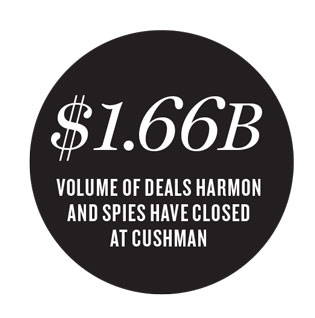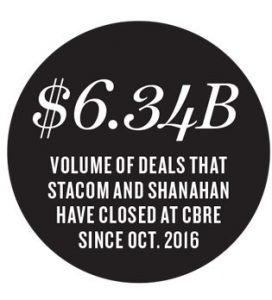From the November issue: When investment sales duo Doug Harmon and Adam Spies jumped to Cushman & Wakefield last year, it was seen as a huge blow to Eastdil Secured. The two had spent a collective 40 years at the firm, ushering in some of the city’s biggest trophy deals, including the $5.3 billion Stuyvesant Town-Peter Cooper Village sale in 2015 and the $1.4 billion sale of the Sony Building the following year. On the flip side, landing Harmon and Spies was seen as a coup for Cushman, catapulting the firm — a perpetual third placer in the New York City market — into a new league and allowing it to compete with the city’s top two investment sales brokerages, Eastdil and CBRE.
But since leaving Eastdil one year ago, Harmon and Spies have lagged behind their biggest competitors at CBRE in the world of big-ticket deals. Their team has closed $3.69 billion in sales of $50 million-plus since last October. But only $1.66 billion of those deals were closed at Cushman — the other $2.03 billion were transactions they worked on at Eastdil that closed after they left.
While that haul would be the year of a lifetime for most brokers, it fell far short of the $6.34 billion in deals that CBRE’s Darcy Stacom and Bill Shanahan reeled in over the same time period, according to a review of transactions by The Real Deal. CBRE, meanwhile, also claimed the largest commercial real estate deal of the year so far: the $2.21 billion sale of 245 Park Avenue to HNA Group in May.
All of this is a major role reversal.
For the past six or seven years, Harmon and Spies have eaten CBRE’s lunch — along with every other firm’s in New York. To put the numbers in perspective, in 2016, with Harmon and Spies still on the payroll, Eastdil closed $22.9 billion in sales. CBRE came in a distant second with $6.7 billion, and Cushman took the No. 3 spot with $4.6 billion. Now it seems that the pecking order could be upended. During the first half of this year alone, CBRE took Eastdil’s No. 1 spot nationwide, brokering $22.6 billion in investment sales, according to Real Estate Alert.
Harmon declined to comment, but his team has been gaining momentum lately, putting several huge transactions into contract — including the whopping $850 million sale of Starrett City (now called Spring Creek Towers) in Brooklyn. And industry insiders say it’s way too soon to judge.
“There’s always a transition period when you leave one organization for another, where there is basically a bit of a pause,” said K Property Group’s Greg Kraut, who helped open Avison Young’s office in New York. “There’s a perception that there’s not a lot of business out of the gate just because of the transition time. And other players at other companies are trying to sprout their heads up.”
And for Harmon and Spies, the external pressure of playing catch-up to CBRE is only half of it.

Sources told TRD that the duo’s success is integral to Cushman’s rumored plans for an initial public offering. The brokerage has ramped up its investment sales game, and its deal volume grew 37 percent last year, to $4.6 billion since its acquisition of Massey Knakal Realty Services in 2015.
But while Harmon and Spies may just be getting warmed up at their new brokerage home, their transition has coincided with a major slowdown in the investment sales market. Manhattan sales volume has plummeted nearly 55 percent, to $14.37 billion during the first nine months of 2017, compared to $31.66 billion during the same time last year, according to Cushman. It’s an environment in which one pricey sale can make the difference between a market leader and the rest of the pack, and the competition for listings is heated.
Woody Heller, co-head of the capital markets group at Savills Studley, said that in one sense, the pressure is off Harmon and Spies. With the volume of commercial sales plummeting, no one is performing particularly well. On the other hand, they do need to demonstrate that they can land new business at a new firm.
“I think anytime you’re in a position to prove yourself, it’s better to be busy than not,” Heller said. “It’s not hard to get a listing, but it is hard to get sellers to sell.”
A tough market
Harmon and Spies’ team — which includes Kevin Donner, Adam Doneger and Joshua King, who all defected with Harmon and Spies from Eastdil — inked its first sizable deal at Cushman in December, when it closed the $150 million sale of Normandy Real Estate’s Chelsea office building at 125 West 25th Street to the Swiss pension fund AFIAA. It was a deal the team brought over with it from Eastdil.
The team has since closed larger transactions, such as the $450 million recapitalization and buyout at 180 Water Street and the $514 million sale of a pair of New York REIT buildings in Chelsea, both of which closed last month. 
And in September, Harmon and Spies were firing on all cylinders. In addition to negotiating the contract for the sale of Starrett City to Brooksville Company and Rockpoint Group (which is slated to close next year pending city and state approval), the duo negotiated Oxford Properties Group’s $700 million contract to buy St. John’s Terminal redevelopment project on the Hudson River and the Vanbarton Group’s deal to buy 990 Sixth Avenue for $320 million.
“There’s been a stickiness to their success,” said Mitch Germain, an analyst at the investment bank JMP Securities. “Obviously, Cushman’s participation in big-ticket transactions is up materially since they joined. [Harmon and Spies] have demonstrated they’ve been able to take that business to another platform.”
But the Harmon-Spies team has struggled to close deals at the same clip as its competitors. A number of potential sales have either fallen off the table or lingered. While the team won the assignment earlier this year to Sell Walton Street Capital’s 49 percent stake in the office building at 237 Park Avenue, the owner abandoned its plans and refinanced the property with partner RXR Realty in June. Other assignments, such as a 50 percent stake in 75 Broad Street and a retail condo at 140 West Street, have stalled. And another big deal negotiated by the brokers — the sale of the leasehold at 2 Herald Square, reported to be in the range of $300 to $350 million — has been stymied by infighting at the property.

Darcy Stacom and Bill Shanahan
Stacom and Shanahan, meanwhile, have made short work of their listings. Case in point: the 1.8 million-square-foot One Worldwide Plaza. In January, the seller, New York REIT, was in the midst of liquidating its assets and had hired Eastdil’s CEO Roy March and David Lazarus to market its 49 percent stake in the building. But when the process stalled, the REIT brought on CBRE to co-broker the deal, which was then quickly put it into contract for $845.3 million in September. Similarly, New York REIT tapped CBRE to market 1440 Broadway alongside Eastdil. The property is expected to sell for roughly $580 million.
But even if Harmon and Spies are billions behind their top rivals at CBRE this year, they are probably not feeling it in their wallets. That’s because brokerages generally pay agents — especially top agents they’ve been aggressively wooing — significant signing bonuses.
“One of the reasons why firms will give any sort of monetary consideration to effectively buy a brokers’ book of business is because there’s significant disruption when that happens,” said J.D. Parker, manager of the tri-state region for Marcus & Millichap. “Call it a friction cost.”
That disruption, Parker added, can be an opportunity for competitors.
“Someone’s going to benefit from not moving,” he said.
Stacom and Shanahan’s team seems to be benefiting, but it has had its setbacks, too. Earlier this year, Stacom and Shanahan lost two protégés: Marcella Fasulo to the Harmon and Spies team and Paul Leibowitz to Savills Studley. And CBRE has also struggled to get listings across the finish line, including a majority stake in Forest City New York and Greenland USA’s Pacific Park megaproject in Brooklyn and Thor Equities’ 590 Fifth Avenue.
 Shanahan told TRD that his team has been able to capitalize on changes in the landscape. He said that, “as market dynamics shift in New York, our market share has increased,” noting that investors are seeking out the team’s expertise. But he declined to comment on specific deals or competitors.
Shanahan told TRD that his team has been able to capitalize on changes in the landscape. He said that, “as market dynamics shift in New York, our market share has increased,” noting that investors are seeking out the team’s expertise. But he declined to comment on specific deals or competitors.
Nonetheless, CBRE is poised to come out on top — especially considering it bested competitor Eastdil on a national scale.
Meanwhile, Eastdil, which has been the perennial market leader both in New York and nationally for years, could be losing its edge. In the wake of the Harmon-Spies exit, Eastdil’s March positioned himself as the face of the firm’s New York operation and took up a permanent residence in the city. It also became clear that March was a quiet rainmaker for the brokerage and he’d actually taken the lead on some of the firm’s blockbuster sales over the last three years, such as the $1.95 billion Waldorf Astoria deal and the $2.2 billion sale of 3 Bryant Park.
“There are certain platforms that have very deep benches. There are some that have much more of a cult of personality,” said a New York City property owner, who spoke on the condition of anonymity. “Eastdil in New York was very much a Harmon and Spies personality, but the real heart is Roy.”
When March sat down with TRD in May, he denied that Eastdil was losing steam due to Harmon and Spies’ departure. And more recently, a spokesperson for the firm said that although the duo “was involved, in varying degrees, in many of our New York City-based office transactions in 2016, it was and is the total team effort approach that led to our success on those transactions.”
The brokerage has indeed been able to maintain some of its big-ticket business. It worked on Ivanhoe Cambridge’s $652 million purchase of the former Goldman Sachs headquarters at 85 Broad Street in May and is co-brokering One Worldwide Plaza with CBRE. The firm is also still marketing a 49 percent stake in Brookfield Place.
Nevertheless, Eastdil has felt the pinch of losing its top team. JMP’s Germain pointed out that several of Harmon and Spies’ listings at Cushman are repeat clients or assignments from their years at Eastdil.
Fighting for market share
When all is said and done, 2017 could prove to be a transformative year in the institutional investment sales landscape. The conversation used to start and end with Eastdil and CBRE, but now Cushman has successfully muscled its way into the mix.
 Germain said that despite CBRE’s dominance this year, Cushman has been grabbing market share at a time when the investment sales market is shrinking and there’s more competition among firms. And already, other big-name brokerages are making inroads. Earlier this year, HFF negotiated the $1 billion sale of a majority stake in 60 Wall Street, and JLL is currently marketing a majority ownership stake in The Plaza Hotel, which is valued at $560 million.
Germain said that despite CBRE’s dominance this year, Cushman has been grabbing market share at a time when the investment sales market is shrinking and there’s more competition among firms. And already, other big-name brokerages are making inroads. Earlier this year, HFF negotiated the $1 billion sale of a majority stake in 60 Wall Street, and JLL is currently marketing a majority ownership stake in The Plaza Hotel, which is valued at $560 million.
“It definitely adds another player into the fold,” said Germain, noting that he doesn’t think Harmon and Spies’ performance will affect Cushman’s IPO much.
“[But] whatever they are contributing to the bottom line clearly helps,” he added.
Marcus & Millichap’s Eric Anton, who left HFF in June, said that with the investment sales market tanking and Harmon and Spies giving Cushman the ammo to be a top player, competition is only going to get more intense among the top deal makers.
“They say business is war,” Anton said. “But real estate is nuclear war.”
—Additional reporting by Mark Maurer
